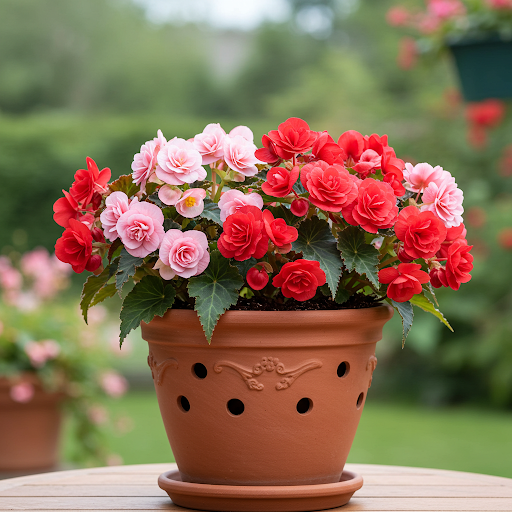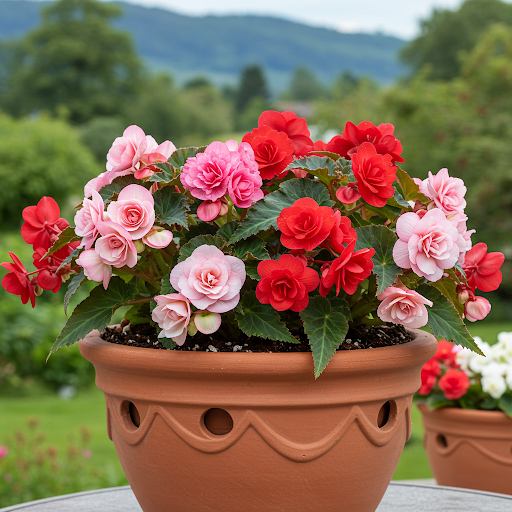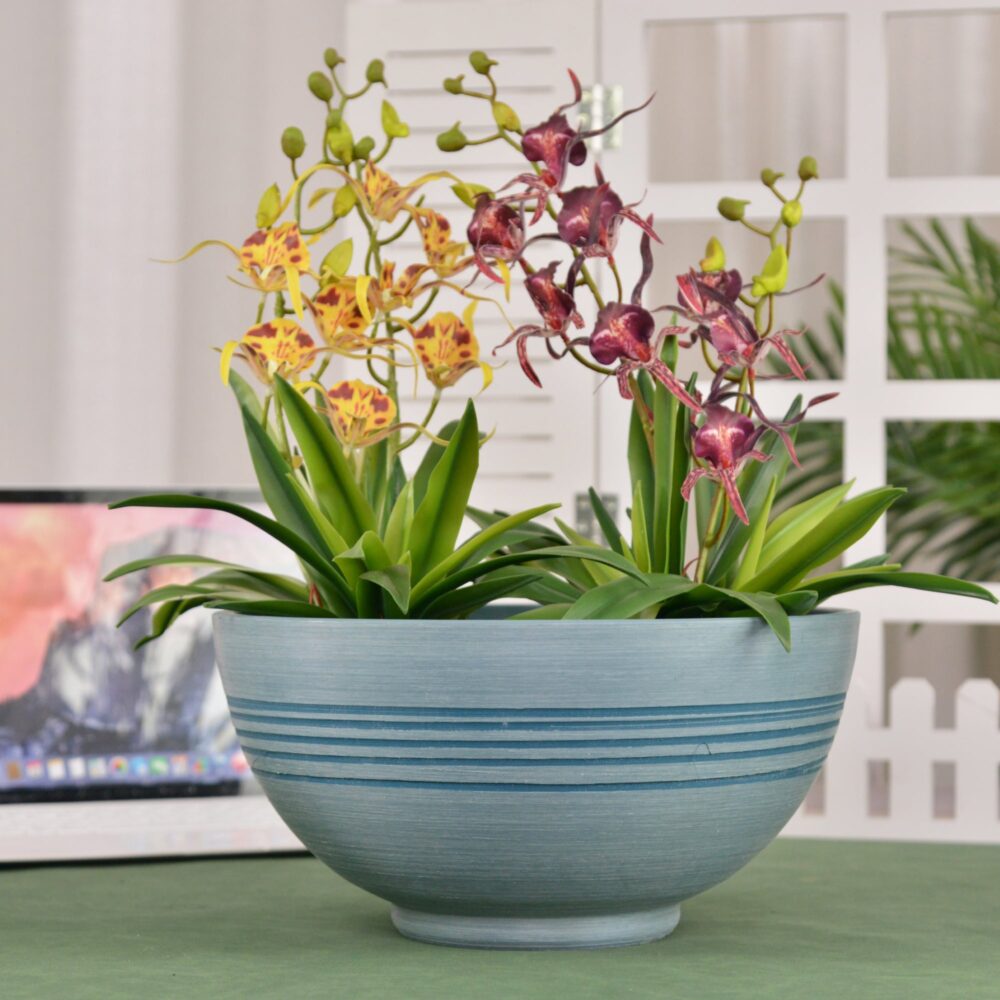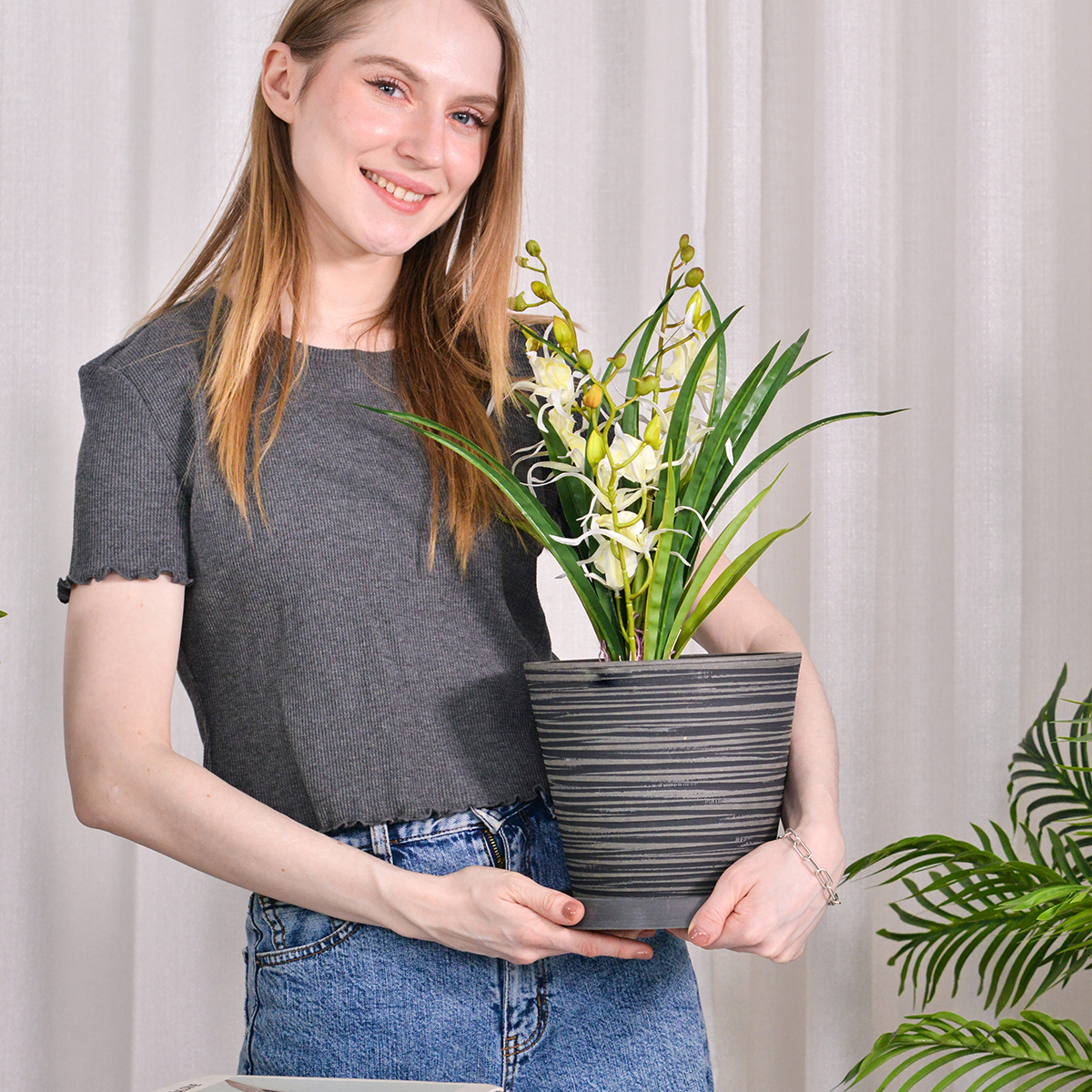Begonias in Pots: The Ultimate Guide to Outdoor Container Gardening with Begonia
Want to add non-stop color and lush foliage to your shaded patio, porch, or balcony? Begonias are an incredibly diverse and rewarding choice for outdoor container gardening, prized for their continuous blooms, stunning foliage, and shade tolerance. From classic wax begonias to dramatic tuberous and angel wing types, there’s a begonia for every style and shade garden. This comprehensive guide will provide you with everything you need to know to grow begonias successfully in outdoor pots, from selecting the best varieties and containers to mastering essential care techniques for a season-long display of begonia beauty.

Begonias
What are Begonias (Begonia)?
Begonias (Begonia) are a vast and diverse genus of flowering plants in the family Begoniaceae, encompassing over 2,000 different species and countless cultivars and hybrids. Native to tropical and subtropical regions around the world, begonias are celebrated for their incredible diversity in leaf shape, color, and texture, as well as their showy and often long-lasting flowers. Begonias can be annuals or perennials (depending on climate and type) and exhibit a wide range of growth habits, from compact and mounding to trailing and upright. They are broadly categorized into groups such as Wax Begonias ( Begonia semperflorens-cultorum), Tuberous Begonias (Begonia x tuberhybrida), Rex Begonias (Begonia Rex-cultorum), Cane Begonias (Angel Wing Begonias), and Trailing/Hanging Begonias. Begonias are prized for their shade tolerance, continuous blooming, diverse foliage, and relative ease of care, making them a top choice for adding color and interest to shady outdoor containers and garden spaces.
Are Begonias (Begonia) Good for Outdoor Pots?
Yes, Begonias (Begonia) are exceptionally well-suited for outdoor pots and container gardening, especially in shaded locations where many other flowering plants struggle. Their versatile growth habits, shade tolerance, and long blooming season make them perfect for filling pots, window boxes, and hanging baskets with vibrant color and lush foliage. Begonias are particularly valuable for brightening up shady porches, patios, balconies, and north-facing gardens where they will thrive and provide continuous beauty throughout the growing season.
Ideal Growing Conditions for Begonias (Begonia) in Pots:
- Types of Begonias for Pots: With such diversity, many begonia types thrive in pots, but some are particularly popular and well-suited for container displays. Consider these beautiful begonia types for your pots:
- Wax Begonias ( Begonia semperflorens-cultorum): Also known as bedding begonias, these are incredibly popular for their low-maintenance nature, continuous blooming in sun or shade, and waxy, succulent-like leaves. Available in green or bronze foliage and flower colors of white, pink, and red. Excellent for mass plantings, borders, and general container use.
- Tuberous Begonias (Begonia x tuberhybrida): Prized for their large, showy, rose-like flowers in a wide range of colors and forms (single, double, ruffled, picotee). Best in partial to full shade, and require more attention to watering and deadheading. Ideal for hanging baskets and statement pots in shady locations.
- Rex Begonias (Begonia Rex-cultorum): Grown primarily for their spectacular foliage, which comes in an amazing array of colors, patterns, and textures (silver, pink, purple, red, green, swirled, ruffled). Flowers are less significant. Best for shade containers where foliage interest is desired.
- Cane Begonias (Angel Wing Begonias): (Begonia hybrids) – Upright, shrub-like growth with distinctive “angel wing” shaped leaves and clusters of delicate flowers. Many varieties have beautifully spotted or patterned foliage. Good for larger pots and vertical interest in shady spots.
- Trailing/Hanging Begonias: (Begonia boliviensis and hybrids) – Bred specifically for cascading habits, ideal for hanging baskets and tall planters, creating waterfalls of blooms and foliage. Varieties like ‘Million Kisses’ and ‘Illumination’ are popular examples.
- Light: Begonias generally prefer partial shade to shade, although light requirements vary depending on the type.
- Wax Begonias: Tolerate full sun to shade, but perform best in partial shade (morning sun and afternoon shade) or bright, indirect light, especially in hot climates.
- Tuberous Begonias: Require partial to full shade. Protect from hot afternoon sun, which can scorch leaves and flowers. Morning sun is tolerated.
- Rex Begonias: Thrive in shade to partial shade. Avoid direct sunlight, which can damage their delicate foliage. Bright, indirect light is ideal.
- Cane Begonias: Prefer bright, indirect light or partial shade. Can tolerate some morning sun.
- Trailing/Hanging Begonias: Generally prefer partial shade to prevent scorching, but some newer varieties are more sun-tolerant. Check specific variety information. Insufficient light will result in fewer blooms, leggy growth, and faded foliage colors. Choose a location for your begonia containers that provides the appropriate light level for the specific type you are growing.
- Soil: Begonias need well-draining soil that is rich in organic matter and slightly acidic. Use a high-quality potting mix specifically formulated for containers or flowers. Peat-based or coco coir-based mixes amended with perlite or vermiculite are excellent choices. Avoid heavy, compacted soil or garden soil in pots. A slightly acidic pH (around 6.0-6.5) is ideal for most begonias.
- Watering: Begonias prefer consistently moist soil, but not waterlogged. Water thoroughly when the top inch of soil feels slightly dry. Water deeply until water drains out of the drainage holes. Allow the very top surface of the soil to slightly dry between waterings, but do not let the soil dry out completely, especially during active growth and hot weather. Begonias are sensitive to both overwatering and underwatering. Overwatering can lead to root rot and fungal diseases, while underwatering will cause wilting and stress. Watering frequency will vary depending on begonia type, light levels, temperature, humidity, pot size, and growth rate. Tuberous begonias are particularly sensitive to overwatering. Check soil moisture regularly and adjust watering accordingly. Water at the base of the plant to keep foliage dry and help prevent fungal diseases.
- Temperature: Begonias are warm-weather plants and thrive in warm temperatures. They perform best in temperatures between 65°F to 80°F (18°C to 27°C). They are sensitive to frost and cold temperatures. Plant begonias outdoors after the last frost in your area. Protect from temperatures below 50°F (10°C). In very hot summer climates, providing shade during the hottest part of the day can be beneficial, especially for tuberous and rex begonias.
- Fertilizer: Begonias benefit from regular fertilization, especially heavy-blooming types like tuberous and wax begonias. Fertilize every 2-4 weeks during the growing season to encourage continuous blooming and lush foliage. Use a balanced liquid fertilizer (e.g., 10-10-10 or 20-20-20) diluted to half strength, or a fertilizer specifically formulated for flowering annuals or begonias. For begonias grown primarily for foliage (like Rex begonias), a fertilizer with a higher nitrogen content can be used to promote leaf growth. Follow package instructions carefully and avoid over-fertilizing, which can lead to salt buildup and leggy growth.
Choosing the Right Pots for Begonias (Begonia):
- Suitable Pot Types: Begonias are adaptable to various pot types, including terracotta, ceramic, plastic, resin, and hanging baskets. Consider these factors when selecting pot types for begonias:
- Terracotta Pots: Porous, allow good aeration and drainage, and aesthetically pleasing, but dry out more quickly, requiring more frequent watering, especially in hot weather. Good for wax begonias and cane begonias that prefer slightly drier conditions.
- Ceramic Pots: Available in many decorative styles, retain moisture better than terracotta, and can add a decorative element to your container garden. Ensure good drainage. Good for tuberous and rex begonias that prefer consistent moisture.
- Plastic Pots: Lightweight, inexpensive, retain moisture well, available in various colors and styles. Choose good quality plastic pots that are durable and UV-resistant. Good for all begonia types, especially hanging baskets and large mixed containers.
- Resin Pots: Lightweight, durable, available in various styles mimicking terracotta or ceramic, and retain moisture well. A good alternative to heavy ceramic pots.
- Hanging Baskets: Ideal for trailing begonias and tuberous begonias, create cascading displays of blooms and foliage. Choose baskets with good water retention and sturdy hangers.
- Window Boxes & Long Planters: Excellent for displaying wax begonias, tuberous begonias, and mixed begonia arrangements on windowsills, railings, or as porch planters. Choose boxes with good drainage and sufficient depth.
- Drainage: Excellent drainage is crucial for begonias to prevent root rot. Ensure your chosen pot has drainage holes at the bottom. Avoid pots without drainage holes. Elevating pots slightly can improve drainage and air circulation around the base. Adding a layer of gravel or pot shards at the base of the pot is generally not necessary if using a well-draining potting mix, but can be done for extra precaution.
- Pot Size: Choose pot sizes appropriate for the type and mature size of the begonia you are planting.
- Individual Wax Begonias: For a single wax begonia plant, a pot that is 6-8 inches in diameter is a good starting size. For multiple plants or larger displays, use larger pots or window boxes.
- Tuberous Begonias: Tuberous begonias need slightly larger pots to accommodate their tubers and large blooms. Use pots that are 8-12 inches in diameter for individual plants, or larger for hanging baskets and mixed containers.
- Rex Begonias: Rex begonias are grown for foliage and don’t need excessively large pots. Pots that are 6-10 inches in diameter are generally sufficient for individual plants.
- Cane Begonias: Cane begonias can grow larger and may need 8-12 inch pots or larger depending on the variety and desired size.
- Trailing/Hanging Begonias: Hanging baskets should be at least 10-12 inches in diameter, and can be larger for more mature displays. Pots for trailing begonias should be at least 8-10 inches in diameter to allow for trailing and root development.
- Depth: Ensure pots are at least 6-8 inches deep for most begonia types. Deeper pots are better for tuberous and cane begonias.
- Color and Style: Choose pot colors and styles that complement your begonia blooms and foliage, and your outdoor décor. Pots in neutral tones can highlight the vibrant colors of begonia flowers and leaves, while brightly colored or decorative pots can add a more whimsical or artistic touch.
Essential Care Tips for Thriving Begonias (Begonia) in Outdoor Pots:
- Watering: “Keep Soil Moist, Avoid Overwatering”. Water thoroughly when the top inch of soil feels slightly dry. Allow the very top surface to slightly dry between waterings. Avoid overwatering and soggy soil. Water less frequently in cool or cloudy weather.
- Light: Provide Shade to Partial Shade. Place begonia pots in a location that receives shade to partial shade, depending on the type. Protect from harsh afternoon sun.
- Fertilizing: Feed Every 2-4 Weeks During Growing Season. Fertilize every 2-4 weeks with a balanced liquid fertilizer or flowering plant fertilizer to encourage continuous blooming and lush foliage. Avoid over-fertilizing.
- Deadheading (Encourage More Blooms & Tidiness): Deadhead spent or faded flowers regularly to encourage more blooms and keep plants looking tidy. Pinch or snip off dead flowers and developing seed pods. Deadheading is particularly important for tuberous begonias to promote continued flowering. Wax begonias are often self-cleaning and require less deadheading.
- Pinching Back (Promote Bushiness – Optional): Pinch back leggy stems or overgrown begonias to encourage branching and bushier growth, especially for wax and cane begonias. Pinching back stem tips can create fuller plants.
- Pest and Disease Control: Begonias are generally relatively pest and disease-resistant, but monitor for common pests like mealybugs, aphids, whiteflies, and spider mites. Powdery mildew, botrytis blight, and root rot can occur, especially in overly humid conditions, with poor air circulation, or overwatering. Ensure good air circulation, avoid overcrowding, water at the base of the plant, and treat any pest or disease issues promptly with insecticidal soap, horticultural oil, neem oil, or appropriate fungicides if necessary. Good sanitation (removing dead leaves and flowers) is important to prevent fungal diseases.
- Tuberous Begonia Dormancy (Winter Care): Tuberous begonias are not winter-hardy in most zones and require special care to overwinter their tubers. In fall, after the first frost, dig up tubers, remove foliage, and store them in a cool, dry, dark place (like a basement or garage) in peat moss or dry vermiculite. In spring, replant tubers indoors to start new growth before moving outdoors after the last frost. Wax begonias and other types are typically treated as annuals and replaced each spring, although wax begonias can sometimes be overwintered indoors as houseplants in a bright location with reduced watering.
Popular Begonia Cultivars for Pots (by Type):
- Wax Begonias: ‘Whopper Series’, ‘Dragon Wing Series’, ‘Big Series’, ‘Cocktail Series’
- Tuberous Begonias: ‘Nonstop Series’, ‘Illumination Series’, ‘Million Kisses Series’, ‘Rieger Begonias’
- Rex Begonias: ‘Escargot’, ‘Iron Cross’, ‘Fireworks’, ‘Red Kiss’, ‘Pink Kiss’ (and countless other cultivars for foliage variety)
- Cane Begonias: ‘Angel Wing Begonias’ (various cultivars with spotted or patterned leaves), ‘Dragon Wing Red’, ‘Dragon Wing Pink’
- Trailing/Hanging Begonias: ‘Begonia boliviensis ‘Bonfire”, ‘Million Kisses Elegance’, ‘Illumination Apricot Shades’, ‘Waterfall Series’

Begonias
In Summary:
Growing Begonias (Begonia) in outdoor pots is a wonderfully rewarding way to bring continuous color and lush foliage to your shaded patios, porches, and balconies. Their incredible diversity, shade tolerance, and long blooming season make them an ideal choice for container gardeners seeking beauty and ease of care in shaded outdoor spaces. By providing shade to partial shade, well-draining potting mix in pots with drainage, watering consistently but avoiding overwatering, fertilizing regularly, and deadheading spent blooms, you can easily cultivate stunning begonia displays in pots and enjoy their beauty throughout the growing season.
For more detailed botanical information and to explore the immense diversity of the Begonia genus, you can visit the Wikipedia page on Begonia.
Important Note: Begonias (Begonia) are considered mildly toxic to humans and pets if ingested, potentially causing minor mouth irritation or digestive upset. Tuberous begonias are noted to be more toxic, particularly the tubers. It’s advisable to keep begonias out of reach of curious children and pets, especially the tubers. The primary care challenges with begonias in pots are providing the right amount of shade (depending on type), avoiding overwatering (especially for tuberous begonias), and ensuring good drainage to prevent root rot. With attention to these type-specific needs and regular deadheading, you can enjoy a season filled with the diverse beauty of begonias in your outdoor containers.**
Modern Plant Pots丨Planter for Indoor Plants,8 inch or 10 inch Plant Pots with Drainage Hole,Decorative Flower Pots
By greenship-seo|2025-04-10T08:32:55+00:00January 7, 2025|Categories: Hand-carving Series|Tags: Decorative Flower Pots, Self-Watering Pots|
20T
By greenship|2024-08-13T06:42:22+00:00August 13, 2024|Categories: Hand-carving Series|
13 inch Planter for Indoor Plants, Set of 2 Modern Decorative Plant Pots with Drainage Hole, Cute Bowl Shape Flower Pots
By greenship-seo|2025-04-10T07:41:46+00:00January 10, 2025|Categories: Hand-carving Series|Tags: Decorative Flower Pots, Self-Watering Pots|
K2-11T
By greenship|2024-08-13T04:21:25+00:00August 13, 2024|Categories: Hand-carving Series|
Planter 6 in W / 8 in W / 12 in W Indoor or Outdoor Plants, Modern Decorative Plant Pots with Drainage Hole, Decorative Flower Pots
By greenship-seo|2025-02-06T13:43:53+00:00January 16, 2025|Categories: Hand-carving Series|Tags: Decorative Flower Pots|
KC3-14A
By greenship|2024-08-16T06:26:30+00:00August 16, 2024|Categories: Hand-carving Series|






